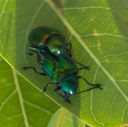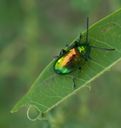Eumolpini
Eumolpini
Classification
- Phylum: Arthropoda
- Subphylum: Hexapoda
- Class: Insecta
- Order: Coleoptera
- Suborder: Polyphaga
- Superfamily: Chrysomeloidea
- Family: Chrysomelidae
- Subfamily: Eumolpinae
- Tribe: Eumolpini
Pronunciation
How to pronounce Eumolpini: /juːˈmɒlpɪnaɪ/
These audio files are automatically generated. While they are not always 100% accurate, they are a good starting point.
Images






Summary
Eumolpini is the largest tribe in the subfamily Eumolpinae, consisting of many leaf beetle genera characterized by specific morphological traits, feeding habits, and global distribution.
Physical Characteristics
Members of Eumolpini typically have a longitudinal median groove on the pygidium, subglabrous bodies, and appendiculate pretarsal claws.
Identification Tips
Look for the characteristic median groove on the pygidium, as well as the overall body shape and claw structure.
Habitat
Eumolpini are found in various habitats around the world, primarily associated with plants as they feed on leaves.
Distribution
Approximately 170 genera of Eumolpini are found worldwide.
Diet
They are herbivorous and primarily feed on leaves of various plants.
Life Cycle
Details on the complete life cycle are generally not specified but follow typical beetle development including egg, larval, pupal, and adult stages.
Reproduction
Reproductive strategies are consistent with those of many beetle species, involving laying eggs on suitable food sources for larvae.
Ecosystem Role
Eumolpini play a role in their ecosystems as herbivores, affecting plant communities and serving as prey for predators.
Collecting Methods
- Light trapping
- Hand collecting from host plants
Preservation Methods
- Pinning
- Ethanol preservation
Evolution
Eumolpini is a large tribe with diverse genera, showing evolutionary adaptation mainly in morphology for feeding and reproduction.
Similar Taxa
- Chrysomelidae
- Megascelidini
Misconceptions
Some genera traditionally classified under different tribes have been synonymized or reclassified under Eumolpini.
Tags
- Eumolpini
- beetles
- leaf beetles
- Eumolpinae
- Coleoptera